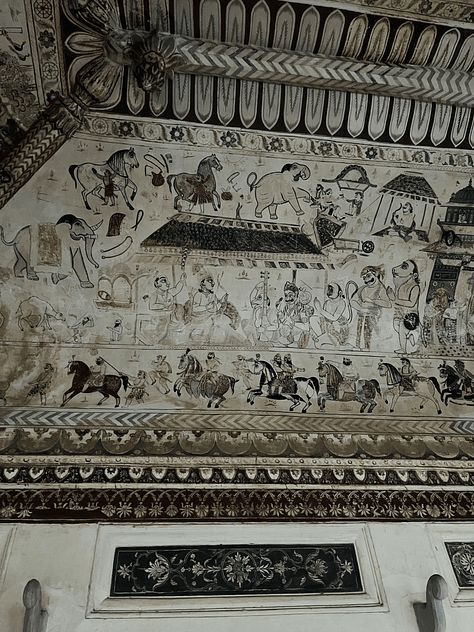Most travelers to Orchha arrive with an itinerary marked by the grand and the expected—Jahangir Mahal, Raja Mahal, the Orchha Fort complex, Ram Raja Mandir, Chaturbhuj Temple, and the somber chhatris lining the Betwa. Lakshmi Temple, if it appears at all, is but a footnote, an optional diversion. And who could blame them? A temple without its deity, a shrine that no longer serves its divine purpose, rarely entices the casual visitor.

Yet, this was once no ordinary temple. Built in 1622 under the reign of Bir Singh Dev, Lakshmi Temple—also called Lakshmi Narayan Temple—once enshrined a golden idol of the goddess of prosperity, a shimmering testament to the Bundela dynasty’s wealth. That treasure was seized by Malhar Rao Holkar in 1752, and a replacement—Radha-Krishna idols installed by Samant Singh—was stolen in 1986. Since then, the inner sanctum has stood empty, its silence a reminder of what was lost.
From a distance, the structure appears austere, almost funereal, its central tower clawing at the sky like a last desperate entreaty. Commissioned by Bir Singh and later renovated by Prithvi Singh in 1793, it sits west of Jahangir Mahal, its square plan cleverly disguising itself as a triangle due to its unconventional entrance. Local guides, ever keen to inject a sense of mystique, claim that from a certain angle, the temple resembles an owl—Lakshmi’s occasional mount, a harbinger of wisdom and wealth. I stood at that very spot, searching for this supposed avian likeness, but instead, I saw something else: a fortress.
Beneath its ornate façade—jali windows filtering the light into patterned lace, cusped arches lending grace to its rigid form, bangla-style roofs curving like the waves of a frozen ocean—the temple is a citadel. The high walls, flanked by bastions, house upper galleries pierced with cruciform holes—gunports in disguise. Defensive slits dot the merlons, sheltering what might once have been heavier artillery.
Dr. A. P. Singh, in his study of Orchha’s fortifications, declares, “This temple is nothing but a ‘keep’ intended for the defensive arrangement of the fort of Orchha.” A shrewd choice, Bir Singh Dev placed it on elevated ground, maintaining a direct line of sight with Bhanderi Darwaza a kilometer away, ensuring an early warning system against attacks from the west. The structure’s outer walls form a diamond, each corner pointing to a cardinal direction, an eastern doorway welcoming the first light of dawn.
But it is within these walls that the true treasure of the temple is found. Not golden idols, nor stolen relics, but something far more elusive—its stories. The walls, the ceilings, the very air seem to hum with forgotten narratives, laid out in murals so intricate, so absorbing, that one does not merely view them; one steps into them.
The temple’s painted corridors are a palimpsest of time, where mythology and history waltz in harmonious disarray. Scenes from the Ramayana, Shrimad Bhagavat, and the Puranas stand side by side with depictions of Bundela court life, Ragamala compositions, and the stylized lovers of Nayaka-Nayika iconography. The ceilings, adorned with iron rings, hint at their former use as swing galleries, turning sacred halls into pleasure pavilions.





And then there are the anachronisms—the images that do not belong, yet command attention. Amidst the divine and the romantic, history has carved a space of its own. The sepia-toned echoes of the Mutiny, nestled within these sacred murals, are perhaps the most haunting of all. The British, rendered in the flat, two-dimensional style of Bundelkhand art, drink, carouse, and plot their next move. One can almost hear the clink of glasses, the twang of a courtesan’s sitar, the murmured “waah” of an appreciative noble.
The scenes shift. British and Indian officials stand in uneasy alliances, their postures stiff with the weight of treaties forged in pragmatism rather than trust. Foot soldiers march, cannons are primed, bayonets glint in the painted sunlight. The siege of Jhansi looms large, its smoke-streaked chaos spilling across the walls. I trace the frantic brushstrokes that capture the charge, the recoil of muskets, the defiant stance of the mutineers against the implacable advance of the Raj. There, amidst the storm of battle, stands a woman in a tower—her back turned, her figure subdued, a queen watching her world collapse.
By the time I step out of the temple’s embrace, I realize I have left with a crick in my neck but a mind ablaze with color and memory. The sun is setting now, drenching Orchha in molten gold. The town, the fort, the temples—all have become a single living canvas, illuminated by nature’s final, fleeting masterpiece.
P.S: The journey isn't over yet! There's another secret hidden within the Lakshmi temple, waiting to be uncovered. What could it be? Stay tuned—I’ll reveal it in the next post. Make sure you don’t miss out—subscribe to the Substack now and be the first to discover the mystery!






The frescos are stunning.